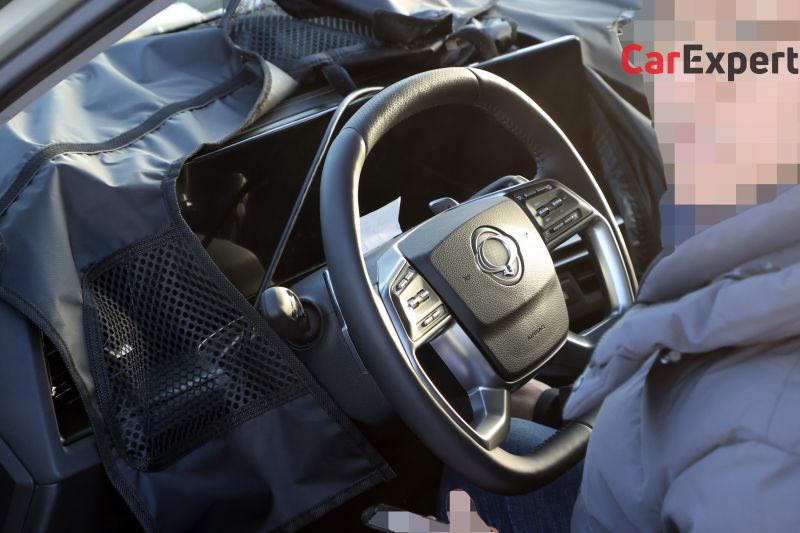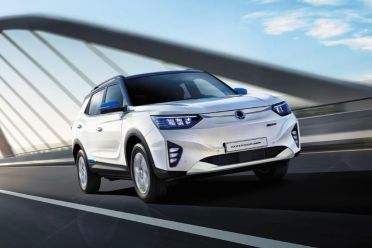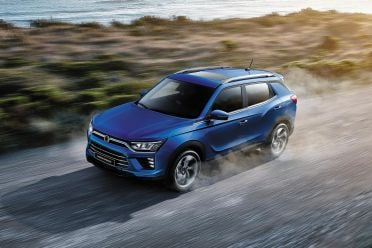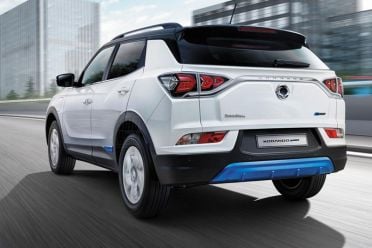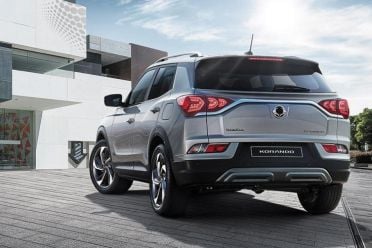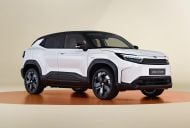SsangYong is readying an electric version of its latest SUV, which is already proving a hit in its home market of Korea.
The SsangYong Torres EV, or whatever it will be called, will be the brand’s second electric model after the Korando e-Motion.
Spy photos show the electric version of the Torres wearing camouflage on both its front and rear ends, and finished in a distinctive tan colour.
The Korando e-Motion differs from its combustion-powered counterpart with a unique front bumper and closed-off grille, along with different tail lights and various blue accents including on the rear skid plate.
The Torres EV could therefore receive similar cosmetic tweaks to distinguish it from the petrol-powered model.
Inside, the Torres EV also appears to differ with a unique screen set-up, featuring the digital instrument cluster and infotainment touchscreen in one assembly.
It’s unclear whether it will use the Korando e-Motion’s powertrain, though this seems likely given the petrol Torres shares its engine with the petrol Korando.
In e-Motion guise, the Korando uses a 61.5kWh battery and a front-mounted electric motor with 140kW of power. Claimed WLTP range is 339km.
“Since the recent completion of SsangYong’s corporate rehabilitation, general business and future product strategy planning with the new owners is currently underway and progressing well,” said a spokesperson for SsangYong Australia when asked about launch plans for the Torres and its EV counterpart.
“All models and concepts from the factory are under consideration for the Australian market but details are yet to be confirmed.”
SsangYong has previously said it doesn’t expect the Torres to arrive in Australia until late in 2023 due to strong demand in Korea.
At 4700mm long and 1890mm wide, the Torres is about the same size as the popular Mitsubishi Outlander.
Until the EV arrives, the only powertrain on offer is a turbocharged 1.5-litre four-cylinder engine producing 125kW of power and 280Nm of torque, mated with a six-speed automatic transmission. Front- and all-wheel drive configurations are available.
Petrol models feature a digital instrument cluster, a 12.3-inch touchscreen infotainment system, and a separate 8.0-inch display for the climate controls.
Available safety equipment includes autonomous emergency braking, blind-spot assist, lane-keep assist, leading vehicle departure alert, and front, front-side, curtain and knee airbags
There’s also available adaptive cruise control with stop/go, tyre pressure monitoring, and automatic high-beam.
The SUV, revealed last June, has been a welcome arrival for the Korean automaker, which is finally turning itself around thanks in large part to its new owner, the KG Group.
After being mired in receivership for over a year, the company is now on a more stable footing and just celebrated its first profitable quarter since 2016.
Globally, SsangYong’s sales were up 35 per cent in 2022 from 84,496 to 113,960 units – up 50 per cent in Korea and 32.4 per cent in Australia, recording its highest-ever sales here.
With its acquisition by the KG Group, SsangYong is set to be renamed to KG Mobility pending board approval – likely to be either granted or denied in March.
“We have decided to go for a new name to fully utilise the strength of SsangYong Motor,” said SsangYong and KG Group chairman Kwak Jae-sun.
“Under the name of SsangYong, the company has a fandom but also has a painful image.
“The new cars will come out as KG, but its car-making history will never change and have the same conditions.”


